Sarah Albee's Blog, page 15
January 12, 2015
nErDcamp Northern New England!
Hey, Maine friends–
Here’s where I’ll be this coming Friday night. I hope you can make it to this (free) event–please drop by my signing table to say hello.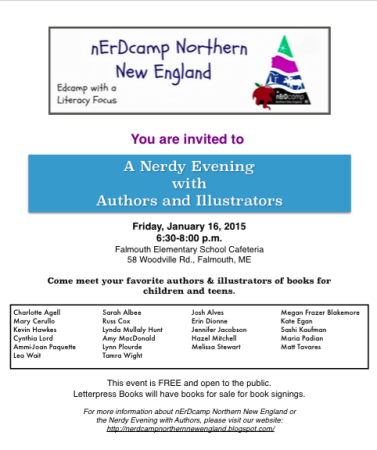
The post nErDcamp Northern New England! appeared first on Sarah Albee.
January 8, 2015
Someone Pinch Me

via Wikimedia commons
For those of us old enough to have grown up with the original Star Trek series, Mr. Spock’s Vulcan nerve pinch is a familiar conceit. Here’s a short video compilation of his technique.
I’ve been researching the history of medicine, and according to this fascinating book by Victor Robinson, MD about the history of anesthesia, compression of a patient’s carotid artery to induce unconsciousness before surgery has been a time-tested, if flawed, technique since ancient Greece. In Greek, carotid means drowsiness. In his History of Animals, Aristotle says: “If these veins are pressed externally, men, though not actually choked, become insensible, shut their eyes, and fall flat on the ground.” (18)
And the technique was still being used a thousand years later. A Spanish physician of the Renaissance reports witnessing it:
The carotids or soporales, that is, sleep-producing arteries, are so named because when they are pressed upon or closed in any way we soon go to sleep. This experiment I saw performed by Realdo Colombo in 1544 in Pisa on a young man in the presence of a number of gentlemen, with no less fear on their part than amusement on ours, we giving them to understand that it was done by sorcery. (39)
The Vulcan nerve pinch seems to be more in the shoulder, but the principal does seem similar.
The post Someone Pinch Me appeared first on Sarah Albee.
January 5, 2015
The Great Connecticut Caper
Happy New Year, everyone!
Today I’m excited to announce that I am to be one of twelve authors (plus twelve illustrators) who will contribute to a serialized adventure story called The Great Connecticut Caper. Here’s the website, and here’s how it works:
Every two weeks, starting yesterday and running through June, a new chapter will be posted at the Connecticut Humanities website. (ctcaper.cthumanities.org)The basic plot will revolve around the famous Gillette Castle, which goes missing. (The Connecticut landmark was voted on and decided by kids and teachers, and Gillette Castle won.) A couple of 11-year-old kids must solve the case. Readers can contribute ideas to help solve the mystery and follow the clues on social media. No one knows how the mystery will end, because it hasn’t been written yet. (My chapter is second-to-last!)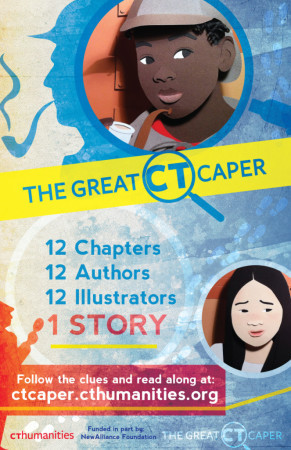
The official launch party, hosted by Connecticut Humanities and the Wadsworth Atheneum, will be this Wednesday, January 7th, from 4:30 to 6:30. You can find out more and register here (it’s free!).
I was so happy when I learned that my audition piece had been selected. Several of my writer and artist friends are also participating. I hope you’ll check it out, even if you don’t live in Connecticut.
The post The Great Connecticut Caper appeared first on Sarah Albee.
December 22, 2014
Happy Holidays!
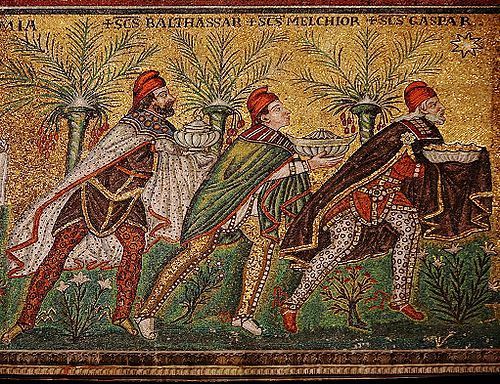 Happy Holidays! I will be taking a blogging break for the next couple of weeks, because I have a book to finish (and relatives to cook for), but will resume my regularly-scheduled blogging on January 5th. Happy New Year to all.
Happy Holidays! I will be taking a blogging break for the next couple of weeks, because I have a book to finish (and relatives to cook for), but will resume my regularly-scheduled blogging on January 5th. Happy New Year to all.
The post Happy Holidays! appeared first on Sarah Albee.
December 18, 2014
How Perfectly Offal
In the midst of this season of overindulgence, I thought I would post about one of my favorite people from history, Catherine de Medici (1519 – 1589), Italian-born wife of Henry II, king of France, and one of her favorite meals: cibreo. This famous Renaissance Florentine dish was a stew made of gizzards, testicles, offal, and rooster coxcombs. Despite her ironclad constitution and robust health, more than once Catherine ate so much of it she nearly died of indigestion.
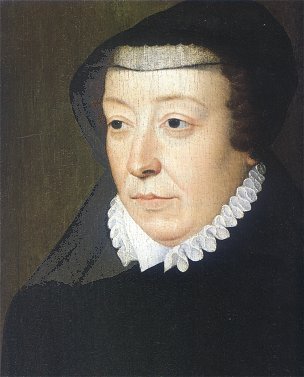 Here’s the recipe, adapted from this website:
Here’s the recipe, adapted from this website:
Catherine’s Cibreo
Serves 4 (or 1 if your name is Catherine de Medici)
You will need (but don’t ask me where to get):
¾ pound of chicken livers
3 ounces of coxcombs
1 tablespoon butter
¼ cup of meat stock
4 cock testicles
2 egg yolks
juice of one lemon
1 tablespoon flour
salt and pepper to taste
Procedure:
Wash the coxcombs, then boil them until the outer membrane separates easily when rubbed. Drain and remove the membranes. Cut the coxcombs into pieces.
Clean and wash the livers.
Thoroughly wash the testicles.
Melt the butter, brown the coxcombs, reduce heat and cook until tender. Add some boiling stock if it gets dry. When the coxcombs are almost done, add the livers and testicles, salt and pepper, and cook for ten more minutes.
In a separate bowl whisk together the flour, lemon juice, and remaining broth. Pour over the offal, remove from pan and serve immediately.
Remember: don’t eat too much, no matter how delicious it is!
The post How Perfectly Offal appeared first on Sarah Albee.
December 15, 2014
Motoring Gear
Not long ago, as we were driving to New York, this guy passed us on the highway.
 It reminded me of fashions people used to wear when autos first came out. I have blogged before about how the first models were open to the air, so passengers wore goggles and “dusters,” and women often wore big, sweeping, net veils over their hats and faces. Here’s one more picture that I came across in the Library of Congress archives, from around 1910:
It reminded me of fashions people used to wear when autos first came out. I have blogged before about how the first models were open to the air, so passengers wore goggles and “dusters,” and women often wore big, sweeping, net veils over their hats and faces. Here’s one more picture that I came across in the Library of Congress archives, from around 1910: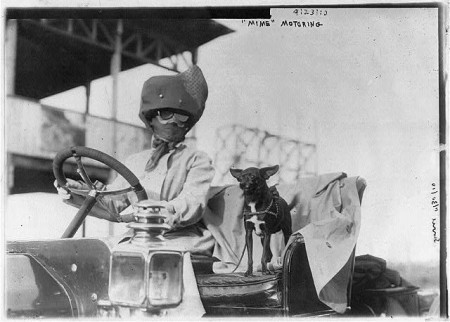 Pretty awesome, isn’t it?
Pretty awesome, isn’t it?
You can read more about these fashions in my upcoming book, Why’d They Wear That? (National Geographic, February 2015.)
image: LOC LC-USZ62-74640
The post Motoring Gear appeared first on Sarah Albee.
December 11, 2014
Banes of My Existence
A very long time ago, when I was taking my SATs, I encountered a short, four letter word in the analogy section that I didn’t know: bane. Reader, if you are under the age of 17 and still have SATs to look forward to, by golly I want to teach you what the word means. It means a cause of harm, ruin, or death. In Anglo Saxon it means “murderer.” I guessed wrong on the test, and subsequently started seeing or reading that word every time I opened a book.
As I research poisons (the subject of my next book), I have found that the common names of many poisonous plants include the word “bane.” They got their names either because they poisoned grazing animals, or because they were used by humans to poison “pest” animals (like wolves and wild dogs). They all contain powerful alkaloids, but have also been used as medicines, and humans have known about them for centuries. Also, it’s amazing how often Shakespeare mentions the “bane” poisons. Here are a few:
Monkshood or Wolfsbane
David Baird [CC-BY-SA-2.0 (http://creativecommons.org/licenses/b...)], via Wikimedia Commons

Henbane
Henbane (Hyoscyamus niger) It may be the poison Hamlet’s ghostly father mentions (“hebenon” is henbane):
Sleeping within mine orchard,
My custom always of the afternoon
Upon my secure hour thy uncle stole,
With juice of cursed hebenon in a vial,
And in the porches of mine ear did pour
The leprous distillment.
cowbane
By Anneli Salo (Own work) [CC-BY-SA-3.0 (http://creativecommons.org/licenses/b...)], via Wikimedia Commons
Root of hemlock, digg’d in the dark
The post Banes of My Existence appeared first on Sarah Albee.
December 8, 2014
The Mill, The Din
Last week, while driving back from Maine, I realized I was passing right through Lowell, Massachusetts, so I stopped by to visit the Boott Cotton Mills Museum.
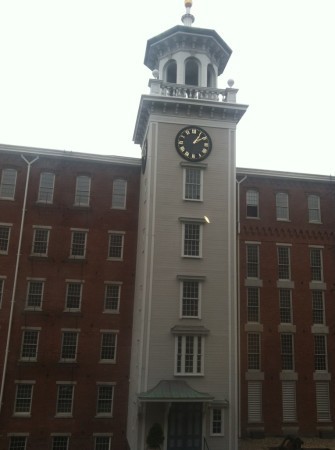 It’s a pretty awe-inspiring structure, which looms over the town. You approach it by walking across a canal, and then you’re in the enormous courtyard.
It’s a pretty awe-inspiring structure, which looms over the town. You approach it by walking across a canal, and then you’re in the enormous courtyard.
The mill workers’ stories have been memorialized in the images of Lewis Hine, and in fictional retellings such as Lyddie by Katherine Paterson and Counting on Grace by Elizabeth Winthrop. I include this part of history in my upcoming nonfiction book, Why’d They Wear That?
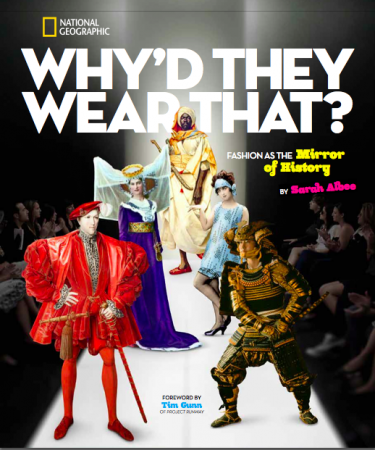 And yet, no amount of reading about how loud the machines were quite prepares you for how loud the machines are. Here’s just a snippet; and this was with just about 20% of the machines in operation. Nearly every account and oral history of mill workers references the noise. Have a listen (I hope this link works):IMG_3583
And yet, no amount of reading about how loud the machines were quite prepares you for how loud the machines are. Here’s just a snippet; and this was with just about 20% of the machines in operation. Nearly every account and oral history of mill workers references the noise. Have a listen (I hope this link works):IMG_3583

image by Lewis Hine LOC
The post The Mill, The Din appeared first on Sarah Albee.
December 4, 2014
Goya at the MFA
Over the Thanksgiving holiday I spent several days in Boston, and I was able to get to the Museum of Fine Arts to see the Goya exhibit. (Fun fact: on days when the museum closes at 4:45, you can get in free starting at 4 pm—a perfect length of time if you’re just going to one exhibit.)
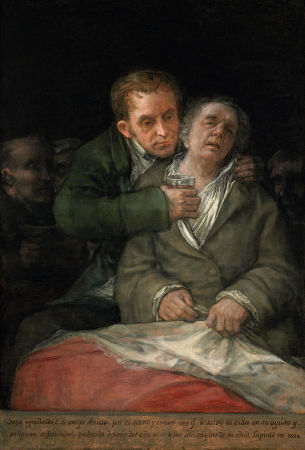 When Goya (1746 – 1828) was 46, he contracted a mysterious disease that caused him to become deaf. Historians aren’t sure what it was. It may have been a viral encephalitis. It may have been lead poisoning, the result of massive amounts of lead white pigment that he ground himself, and used for priming canvases. It was so cool to see the above painting in real life. It’s a self portrait of the artist with his doctor, Arrieta, who is gently supporting the sick painter and offering him medicine.
When Goya (1746 – 1828) was 46, he contracted a mysterious disease that caused him to become deaf. Historians aren’t sure what it was. It may have been a viral encephalitis. It may have been lead poisoning, the result of massive amounts of lead white pigment that he ground himself, and used for priming canvases. It was so cool to see the above painting in real life. It’s a self portrait of the artist with his doctor, Arrieta, who is gently supporting the sick painter and offering him medicine.
I also got to see this one, of the Duchess of Alba. Goya painted the Duchess–a famous beauty– several times, but this one, from 1797, is one of my favorites. I love how she’s pointing down at the sand, at an inscription that says something along the lines of “Only Goya could have painted this.” (My Spanish-speaking daughter came along, and translated it for me.)
 The exhibit runs through January 19th, and is well worth a visit. (Especially if you can get there at 4 pm for free!)
The exhibit runs through January 19th, and is well worth a visit. (Especially if you can get there at 4 pm for free!)
The post Goya at the MFA appeared first on Sarah Albee.
December 1, 2014
Patently False
In the late nineteenth century, patent medicine makers printed postcard sized advertisements for their products and distributed them to druggists. Most of these so-called trade cards had a picture on one side, and a description of the product on the other. The pictures ranged from imaginative to bizarre to grotesque to racist. Manufacturers were not required to divulge ingredients, and they often made wildly fraudulent claims. Worse still, some of these patent medicines contained powerful poisons. Many were some combination of sugar, alcohol, and opiates.
Here’s a little sampling for you:

“Liquid bread.” Another term for “beer.”

I don’t think this one’s poisonous, but the note the racist caption, which reads: Your hand is as soft, sweet Mistress O’Doyle, as me harness whin rubbed wid vacuum oil.”
The medicines claimed to cure everything from constipation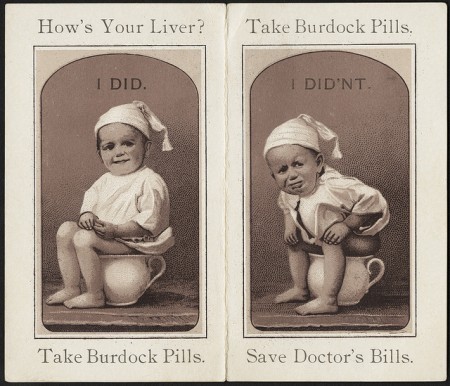 to consumption.
to consumption.

Shiloh’s consumption cure was introduced about 1873. It contained some combination of chloroform, heroin, and Prussic acid (cyanide).
Then there were the baby medicines for teething, colic, and diarrhea. Dr Bull’s contained morphine: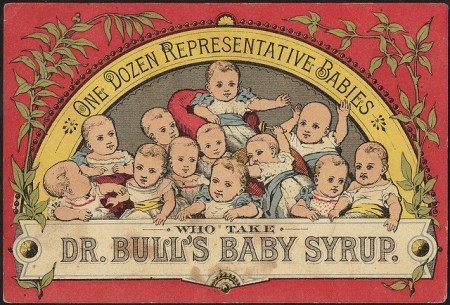 And Mrs. Winslow’s soothing syrup contained alcohol and opium:
And Mrs. Winslow’s soothing syrup contained alcohol and opium: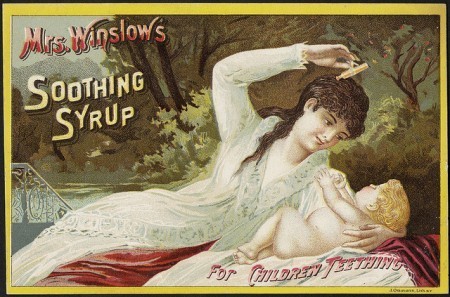 No wonder Parker’s tonic brought the bloom of health to the cheek. It was 83 proof.
No wonder Parker’s tonic brought the bloom of health to the cheek. It was 83 proof.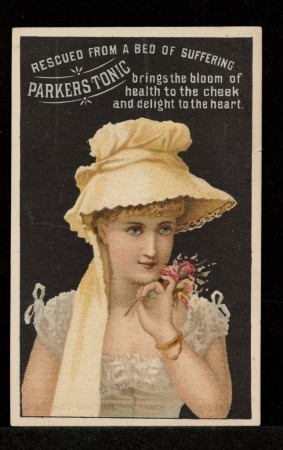 And then there was Dr Thomas’ Eclectric oil, which contained opium, alcohol, and chloroform.
And then there was Dr Thomas’ Eclectric oil, which contained opium, alcohol, and chloroform.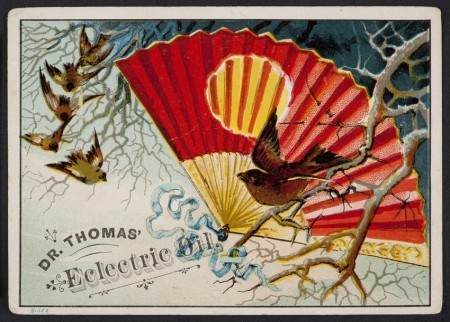 One of the most successful hawkers was Dr. Ayer of Lowell, Massachusetts. By 1873 he was producing 630,000 daily doses of Ayer remedies. The Sarsaparilla was mostly alcohol (40 proof). The pictures on some of these are just flat-bizarre. Remember, these are ads.
One of the most successful hawkers was Dr. Ayer of Lowell, Massachusetts. By 1873 he was producing 630,000 daily doses of Ayer remedies. The Sarsaparilla was mostly alcohol (40 proof). The pictures on some of these are just flat-bizarre. Remember, these are ads.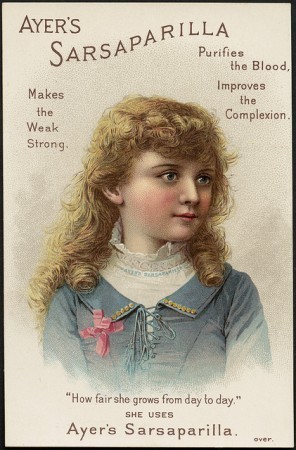

A veiled allusion to improving male “virility.”

Rather than rescuing drowning sailors, these mermaids are salvaging casks of Ayers Hair Vigor.

I mean—???
http://www.nlm.nih.gov/exhibition/ephemera/addiction.html
http://www.pilgrimhallmuseum.org/pdf/Patent_Medicine.pdf
http://www.mc.vanderbilt.edu/diglib/s...
The post Patently False appeared first on Sarah Albee.






